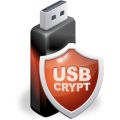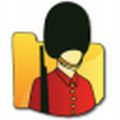Zilnic oferim programe licențiate GRATUITE pe care altfel ar trebui să le cumpărați!

Giveaway of the day — USBCrypt
USBCrypt a fost chilipirul zilei în 3 iunie 2010
USBCrypt este un instrument redutabil de criptare pe care îl puteţi folosi pentru a proteja stick-ul USB sau alte dispozitive mobile sau fixe de stocare a datelor prin criptarea puternică AES cu parolă. Mediile criptate astfel pot fi folosite pe alte computere care nu au instalat programul USBCrypt.
USBCrypt poate proteja orice USB, flash, stick USB suportat de Windows. Mediile astfel protejate pot fi utilizate pentru a stoca orice tip de fişiere şi documente: teste, foi de calcul, fişiere financiare, fişiere video, MP3-uri. Opţiunea de creare a unui fişier "spare key" poate fi utilizată în cazul în care uitaţi parola.
Cerinţe minime de sistem:
Windows 7/Vista/XP/2000 (x32 and x64)
Publicist:
WinAbility Software CorpPagina de pornire:
http://www.winability.info/Dimensiunile fişierului:
9.47 MB
Preţ:
$29.95
Titluri promovate

AB Commander pentru Windows 7/Vista/XP/2000 pe 64 de biţi – următoarea generaţie a administratorului de fişiere cu ecran dublu şi înlocuitor Explorer care vă permite să lucraţi cu fişiere şi directoare rapid şi eficient. Include un despărţitor de fişiere, sincronizator de directoare, previzualizare a imaginilor, editor text cu opţiuni complete de editare şi multe altele. Poate fi complet personalizat şi este uşor de folosit. Gratuit pentru 30 de zile (versiunea completă).

Folder Guard pentru Windows 7/Vista/XP/2000 pe 64 de biţi – o utilitate redutabilă de securitate şi control al accesului la documente care poate fi utilizată pentru a proteja cu parolă sau a ascunde complet fişierele şi directoarele de alţi utilizatori, cu care puteţi controla accesul la fişiere prin filtre, puteţi restricţiona accesul la Panoul de Control şi multe altele. Faceţi directoarele invizibile pentru orice aplicaţie, inclusiv Explorer, Office, command prompt. Gratuit pentru 30 de zile (versiunea completă).

MySecretFolder pentru Windows 7/Vista/XP/2000 pe 64 de biţi este o utilizate de securitate uşor de folosit care poate ascunde sau bloca un director cu o parolă. Alţi utilizatori nu vor putea să vizualizeze conţinutul fişierelor personale dacă nu cunosc parola pe care dvs. aţi setat-o. Face invizibil directorul protejat pentru orice aplicaţie, inclusiv Explorer, Ofiice, commant promt. Gratuit pentru 30 de zile (versiunea completă)

Comentarii la USBCrypt
Please add a comment explaining the reason behind your vote.
Download and installs easily. Activated automatically... so no hassle there. Seems to work fine in Windows XP SP3 though I haven't got a chance to test encrypting a USB drive yet. I like the fact that you can access the encrypted files even on a PC without USBCrypt as it automatically installs a portable version of itself on the unencrypted part of the USB drive. On Windows-only PC, of course.
A free alternative is TrueCrypt, which has the advantage of being cross-platform and can also run as a portable app from the USB drive itself.
Save | Cancel
#7 - Retell - Some of the programs that we get from GOTD have little programs in them that automatically search for and install updates. It is after this update process that they revert to 'trial' versions and expire on us after a set period of time. Some programs don't do it automatically but will give us a message "New version available"and getting the update will screw us out of the freebie we currently have working on our machine.
# 2 of the terms and conditions (up above) says, "No free upgrades to future versions" yet some programs will, as said, automatically upgrade so you have to check and turn off that function if the program is set for it. Would be nice if the setup instructions would tell us about auto-update and turning it off or if the settings would be 'opt in' as opposed to 'opt out' but they don't so one has to check if the options are available. - Ethical or unethical? That is debatable. I'd prefer they be upfront about it. -
I've lost quite a few good programs through this system but they were free to start with. So it goes. But if the free software does the auto-update with a program that is setting up encryption/passwords and you forget the password... - - Be careful out there.
Be careful out there.
Save | Cancel
Hello everyone, Andrei from WinAbility Software here. First of all, thank you all who voted up for USBCrypt (all 101 of you :-) ) Let me answer some question posted so far:
- If you use the encrypted drive on another computer, the admin right are required (once per Windows session);
- If you plug the drive into a Mac or Linux computer, the drive will remain encrypted, because the software does not run on Mac or Linux;
- If you back up the host drive, the encrypted data will be saved in the encrypted form. If you backup the encrypted files after entering your password, they will be backed up in the decrypted form.
If you have other questions, please note that although this promotion does not include the standard technical or customer support we usually provide, we've set up a special Facebook page for the GOTD customers:
http://www.facebook.com/pages/Encryption/115647851807099
Please feel free to post your comments or questions on the Wall or within the Discussions tab, and we will try to answer your questions there.
Thanks again!
Save | Cancel
At the moment the rating is 66 (34%) thumbs up, # 129 (66%) thumbs down, and yet there are no negative comments.
Would someone who has given it the thumbs down please explain what's wrong with it, or whether it's simply because they don't want it.
Save | Cancel
USBCrypt creates an encrypted virtual disk on the target drive, & adds a mini-copy of itself to the drive so it's usable on PCs/laptops without USBCrypt installed -- the software copied to the encrypted drive includes both 32 & 64 bit versions, & is only for opening the encrypted virtual disk [it can't encrypt another drive]. The developer provides a manual on their site, including a printable version that comes in handy using PDFCreator [or some other PDF print driver] -- [winability.com/usbcrypt/users-guide-printable.htm]. This manual recommends removing all files from a USB drive before adding USBCrypt, & this is repeated during install -- the USB stick I used to test doesn't have a partition structure that's compatible with Paragon or EASEUS partition software, so I couldn't track whether partitioning was effected or not, but I'd suggest following the developer's advice & backing up any hard drives before using USBCrypt to add an encrypted virtual disk to a hard drive. Since that partial copy of USBCrypt is added when you set up an encrypted v/disk you should always have access, but, remember that today's GOTD does not come with or need a key, & the included setup.exe is only good today.
USBCrypt uses the Microsoft Windows Installer, which can & does cause problems occasionally [normally based on how well apps that you've installed previously using the win installer were written -- if WinAbility, the developer, screwed up, it *likely* won't show up until you install something in the future using the win installer]. USBCrypt installs to 2 folders by default under Program Files --> USBCrypt & WinAbility Encryption Driver.10.2.0.1180 ... 2 files are added to the Windows' Installer folder, & [monitored in XP Pro SP3 32] by default password reset files are stored in Documents and Settings\[UserName]\Local Settings\Application Data\USBCrypt. While drivers are added, they aren't placed in the normal Windows folder location, & needed copies are included when you create an encrypted v/disk on a USB stick. Bear in mind that whenever drivers are used that's something else that can go wrong [potential incompatibilities, restrictions on PCs where you try to use the encrypted USB stick etc]. In the registry my logs show both WED1180 & Winability Encryption Driver added to ...ControlSet\Services. Windows' Admin Tools -> Services shows the WinAbility Encryption Driver set to Automatic [i.e. starts with Windows], & it in a nutshell watches for you to insert a USB stick with an USBCrypt v/disk.
During install &/or when you start the app from the Start Menu, the wizard's started to create an encrypted v/disk... when you do, on the USB stick you'll wind up with USBCrypt.exe [double click this to start the encryption/decryption app], autorun.inf [starts that app if autorun is turned on for the PC/laptop you're using], & a folder called: USBCrypt-System. That folder holds 10 program files plus the encrypted v/disk & a file with the same name. You allot however much space to the v/disk when you create it, & the v/disk uses it all -- it does not grow/shrink dynamically. Once the USBCrypt [installed or on-key app] is started you enter the v/disk name & password, & the encrypted v/disk shows up & behaves in Windows Explorer as another drive. Because you're adding another layer between you & your storage device, it will be slower.
The WinAbility Software site has info on the encryption used etc, but not being open-source [which can be independently evaluated], IMHO you shouldn't place as much confidence in USBCrypt as TrueCrypt, plus it doesn't have it's stealth features. That said, TrueCrypt isn't for everyone -- no app is -- so for many PC/laptop users this might be a good alternative. In contrast the similar Wondershare app recently on GOTD [Wondershare USB Drive Encryption] is more light weight, both in terms of features & of it's impact on Windows &/or a USB stick. Personally I'd be more inclined to use today's GOTD for biz purposes, & Wondershare's alternative if I just wanted to keep nosy co-workers, family members, &/or kids out of my stored files.
Save | Cancel